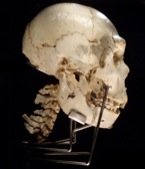Homo heidelbergensis and the muddle in the middle
Sat, Oct 10 2009 11:45 | Palaeoanthropology | Permalink

At the conference, much attention was focused on the Middle Pleistocene "muddle in the middle" [3], particularly the role of Homo heidelbergensis in hominin evolution. While H. heidelbergensis possesses both archaic and derived traits intermediate between H. erectus and later members of the Homo genus, it lacks uniquely derived traits or autapomorphies, which are a prerequisite for defining a species.
H. heidelbergensis has traits that have been interpreted as nascent Neandertal autapomorphies, leading some researchers to propose that there was a continuous evolution of Neandertals [4-6]. This accretion model would make H. heidelbergensis a chronospecies on the continuum of the Neandertal lineage, a view championed by Jean-Jacques Hublin. The accretion model proposes that Neandertals evolved by anagenesis, i.e. non-branching evolutionary change.
Another scenario views both the European and African H. heidelbergensis as a single species, and the last common ancestor of both Neandertals and modern humans. Alternatively, H. heidelbergensis could have become isolated in Europe and evolved into Neandertals, while the African populations led to modern humans.
During the conference, Ian Tattersall noted that while the accretion model explains some of the variation in the Middle Pleistocene, it cannot account for some outliers, such as the 28 or so specimens that have been recovered from the Sima de los Huesos in Atapuerca, Spain. Tattersall is not the first author to call the accretion model into question [7]. Recent dates have placed the Sima fossils at just over half-a-million years old. Based on the dissimilarity between these fossils and the penicontemporaneous H. heidelbergensis from the rest of Europe, Tattersall proposes that two hominin lineages coexisted in Europe before the arrival of H. sapiens. He suggests that one line (which may include the Sima specimens) led to the Neandertals, while the branch which included H. heidelbergensis went extinct. If Tattersall is correct it would mean that the Sima fossils, which are currently classified as H. heidelbergensis, must be designated another name.
Hublin is to his guns and doesn't see any need to reclassify the Sima material. He goes as far as to suggest binning the species name H. heidelbergensis altogether and instead reassigning all these Middle Pleistocene fossils as H. neanderthalensis. Whatever the outcome is in this debate, it appears that hominin evolution in the Middle Pleistocene is more complex than we have previously suspected.
References
1. Balter M. New work may complicate history of Neandertals and H. sapiens. Science 2009; 326:224-5.
2. Darwin C. The descent of man, and selection in relation to sex. New York, A. L. Burt; 1874.
3. Butzer KW, Isaac GL, International Congress of Anthropological and Ethnological Sciences 9C1. After the Australopithecines : stratigraphy, ecology, and culture, change in the Middle Pleistocene . The Hague : Mouton ; Chicago : distributed in the USA and Canada by Aldine; 1976.
4. Hublin. Paleogeography, and the evolution of the Neandertals. In: Akazawa, Aoki, Bar-Yosef, Eds. Neandertals and Modern Humans in Western Asia. New York: Plenum Press; 1998:295-310.
5. Hublin. Climatic Changes, Paleogeography, and the Evolution of the Neandertals. In: Akazawa, Aoki, Bar-Yosef, Eds. Neandertals and Modern Humans in Western Asia. New York: Plenum Press; 1998:295-310.
6. Martinón-Torres M, Bastir M, Bermúdez de Castro JM, Gómez A, Sarmiento S, Muela A, Arsuaga JL. Hominin lower second premolar morphology: evolutionary inferences through geometric morphometric analysis. J Hum Evol 2006; 50:523-33.
7. Hawks JD, Wolpoff MH. The accretion model of Neandertal evolution. Evolution 2001; 55:1474-85.
